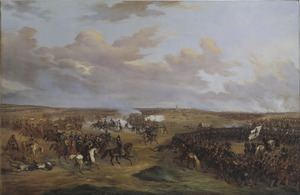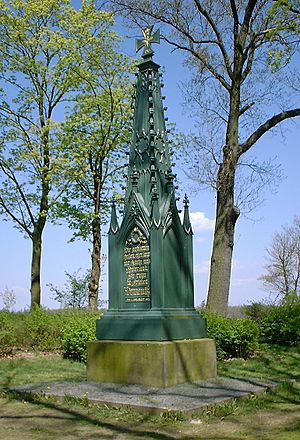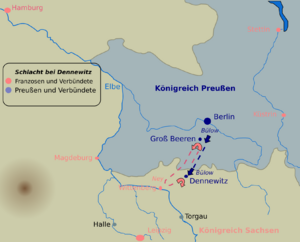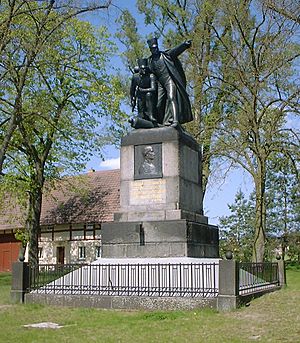Battle of Dennewitz facts for kids
Quick facts for kids Battle of Dennewitz |
|||||||
|---|---|---|---|---|---|---|---|
| Part of the German campaign of the Sixth Coalition | |||||||
 Painting by Alexander Wetterling, 1842 |
|||||||
|
|||||||
| Belligerents | |||||||
| Commanders and leaders | |||||||
| Strength | |||||||
| 80,000–85,000 150 guns |
45,000–70,000 200 guns |
||||||
| Casualties and losses | |||||||
| 9,700-11,000 Details: 9,000 killed or wounded 2,000 captured |
20,000-23,215 53 guns Details: 6,500 killed or wounded 13,500 captured |
||||||
The Battle of Dennewitz was a major fight that happened on September 6, 1813. It was part of the German campaign during the Sixth Coalition. French forces, led by Marshal Michel Ney, fought against the Allied Army of the North. This Allied army included soldiers from Prussia, Russia, and Sweden. Their leaders were Crown Prince Charles John of Sweden, Friedrich Wilhelm von Bülow, and Bogislav von Tauentzien.
The battle took place near Dennewitz, a village in Brandenburg, Prussia. This area is about 40 kilometers (25 miles) southwest of Berlin. The Allies won a big victory. This win stopped Napoleon's plan to capture Berlin and force Prussia out of the war. The French defeat was so bad that some German allies started to turn against Napoleon. The losses at Dennewitz also helped lead to Napoleon's final defeat a month later at the Battle of Leipzig.
Contents
Why did the Battle of Dennewitz happen?
In August 1813, Napoleon wanted to capture Berlin, the capital of Prussia. His main goal was to make Prussia leave the war. Berlin was defended by the Allied Army of the North. This army had soldiers from Prussia, Russia, North Germany, and Sweden. It was led by Crown Prince Charles John of Sweden, who used to be a French Marshal named Bernadotte.
Marshal Nicolas Oudinot led three French army groups towards Berlin. They advanced on different roads. The Allied Army was ready for them. They were set up along an east-west line. On August 23, there was fighting at Blankenfield, Grossbeeren, and Sputendorf. This is known as the Battle of Grossbeeren. The Allies won these fights, and Oudinot had to retreat. After this, Napoleon put Marshal Michel Ney in charge of the French forces.
How did the battle unfold?
Ney had about 60,000 soldiers. He started moving towards Berlin again on September 6. He first moved east, planning to attack Berlin from the southeast. He thought Napoleon would support him from that direction.
Crown Prince Charles John of Sweden had learned from Oudinot's earlier attack. He knew the French often spread out on the few north-south roads. So, he set a trap. The Allied forces were ready to defend. Any Allied group that met the main French attack would hold them back. This would give time for the rest of the army to arrive. They could then attack the French on the many east-west roads.
Ney decided to move his whole army down just one road. This caused his army to stretch out for miles, just as Bernadotte had expected. General Bülow's III Corps was shadowing Ney's army to the north. They met at Dennewitz.
Early fighting and key moments
The Prussian General Tauentzien was at Jüterbog, blocking Ney's path to Berlin. Ney's troops reached Dennewitz as Bülow was coming towards Jüterbog from the north. To stop Tauentzien and Bülow from joining forces, the French took control of a hill north of Dennewitz. This hill is now called Denkmalsberg.
Even though Tauentzien's soldiers faced early problems, Bülow saved the day by taking the hill. Then, the Brandenburg Dragoons (a type of cavalry) charged down the hill. This gave the Prussian soldiers who had struggled earlier time to regroup.
There were some issues within the French army. They didn't have enough cavalry soldiers or horses. This was because of earlier wars, like the one in Russia in 1812. This meant they couldn't scout ahead very well. Also, Marshal Oudinot was unhappy about being under Ney's command. Marshal Ney was determined to reach Berlin quickly. This, along with poor scouting, led the French army right into the Allied defense.
Tauentzien's soldiers were pushed back at first. But then Bülow's soldiers arrived and helped them get back the lost ground. Bülow then took command of both Prussian groups for the rest of the day.
Turning the tide
The battle went back and forth. It looked like the French might win. But then, Ney made a mistake. He didn't get enough support from Oudinot. Also, a rainstorm made it hard to see what was happening. Ney ordered Oudinot to form a reserve, meaning to pull back some troops.
Oudinot's pullback looked like a retreat to the Prussians. So, the Prussians attacked even harder. The French were forced back under heavy pressure. At this point, Bernadotte arrived with the rest of the Army of the North. He had over 45,000 men, including Russian and Swedish soldiers.
Bernadotte then opened fire on the French with a huge group of 150 cannons. He also used British Congreve Rockets, which were early artillery rockets. Their inventor, Sir William Congreve, was there himself. These rockets helped 70 fresh infantry groups and 10,000 cavalry soldiers attack the French left side, which was already falling apart.
The French were already retreating from the Prussians. With this new attack, they became completely disorganized. They were totally defeated. Prussian and Swedish cavalry chased them into the next day. The French lost many soldiers. About 10,000 French soldiers were killed or wounded. The Prussians lost 9,700. During the chase, the Swedish and Prussian cavalry captured another 13,000 French soldiers.
In total, the French lost 413 vehicles, 53 cannons, 4 flags (called Eagles), and 23,215 men. Ney finally reached safety at Torgau. He wrote to another general, "I have been totally beaten, and still do not know whether my army has reassembled."

What happened after the battle?
The Allied victory at Dennewitz had a big impact across Germany. Many Germans were unhappy with French rule. Tyrol started a revolt. Bavaria left the war because Napoleon's plan to take Berlin had failed. Other German states also started to doubt their support for the French Empire.
Crown Prince Bernadotte used this feeling of German pride. He asked the Saxon Army to join his side. He was popular with them because he had led them in an earlier war. Many Saxon soldiers were unhappy with the French. A month later, the Saxons joined Bernadotte's army. They switched sides at a very important moment during the Battle of Leipzig, which helped the French lose.
The French defeat at Dennewitz ruined Napoleon's plans. Napoleon was very angry with Ney for his failures. Napoleon then started planning a new campaign. He wanted to lead it himself. He aimed to capture Berlin and push Bernadotte's army back to the sea. He also wanted to punish Bernadotte, who used to be his Marshal. However, Blücher and Bernadotte were careful. They avoided Napoleon's attacks. They supported each other, retreating when needed and advancing when they could. This stopped Napoleon from catching either army out in the open. This eventually led to Napoleon deciding to fight the big battle at Leipzig.
The winners of Dennewitz received many awards. For his great leadership and bravery, Bülow was given the Grand Cross of the Swedish Order of the Sword by Bernadotte. Later, the King of Prussia made him a Count. Bernadotte received the important Russian Order of St. George. He also got the Grand Cross of the Iron Cross and the Austrian Order of Maria Theresa.
Who fought in the battle?
Here are some of the main groups that fought in the Battle of Dennewitz.
Allied Forces
The main commander for the Allies was Crown Prince Charles John.
- III Corps: Led by Friedrich Wilhelm Freiherr von Bülow.
* Included Prussian infantry and cavalry units. * Had Russian Cossack cavalry. * Used many cannons.
- IV Corps: Led by Bogislav Friedrich Emanuel von Tauentzien.
* This group was not heavily involved in the fighting.
- Swedish Corps: Led by Field Marshal Curt von Stedingk.
* Also not heavily involved.
- Russian Corps: This group was also not heavily involved.
French Empire Forces
The main commander for the French was Marshal Michel Ney.
- IV Corps: Led by General Henri Gatien Bertrand.
* Included French, Italian, and Württemberg divisions. * Had cavalry and artillery.
- VII Corps: Led by General Jean Reynier.
* Included Saxon and French divisions. * Had Saxon cavalry and artillery.
- XII Corps: Led by Marshal Nicolas Oudinot.
* Included French and Bavarian divisions. * Had cavalry and artillery.
- III Cavalry Corps: Led by General Jean-Toussaint Arrighi de Casanova.
* Included various light and heavy cavalry units.



